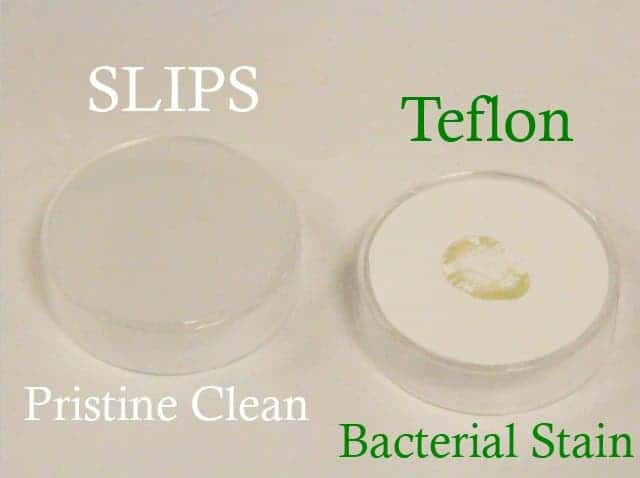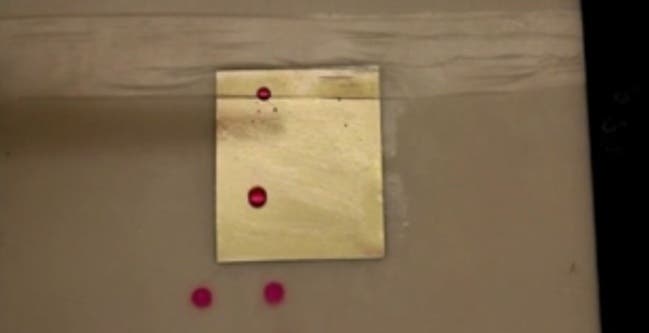Used in everything from skyscraper girders, automobiles, and appliances to thumb tacks and paper clips, steel is one of the world’s most vital materials. While there’s been a great amount of research invested into steel, most of it has concentrated on making various grades of steel, with little focus on the surface itself. Understanding that there’s a great interest and need for steel surfaces that can stay clean and don’t corrode under harsh environmental conditions, a group of material scientists at Harvard have come up with a squeaky clean coating that does just that.
Super steel
Called the Slippery Liquid-Infused Porous Surfaces (SLIPS), the surface coating is heralded as the most durable anti-fouling and anti-corrosive material to date. More specifically, it’s a nanoporous tungsten oxide grown directly on the steel through an electrochemical technique – a standard manufacturing procedure that doesn’t require millions worth of new tech to be deployed.
SLIPS isn’t uniformly applied, but rather in ultrathin film of hundreds of thousands of small islands. This proved to be important, since the steel doesn’t suffer mechanical degradation if one of the islands breaks. This means that the resulting steel carries both repellent and abrasive properties at the same time, which was impossible until now.

Accelerated corrosion test, in which unmodified stainless steel (300 grade) (right sample)and the lower part of the TO-SLIPS sample with a 600-nm-thick porous TO film on steel (left sample)were exposed to very corrosive Glyceregia stainless steel etchant. (a-h) Images show corrosion evolution as a function of contact time.
To test the material, engineers scratched the steel coated surface with everything from tweezers, to screwdrivers, and even pummeled hundreds of heavy beads. When it was tested against water, corrosive materials and even bacterial infested sludge, all of the liquids were repelled from the steel. Moreover, the resulting steel proved to be stronger sans the coating.
“Our slippery steel is orders of magnitude more durable than any anti-fouling material that has been developed before,” said Aizenberg. “So far, these two concepts – mechanical durability and anti-fouling – were at odds with each other. We need surfaces to be textured and porous to impart fouling resistance but rough nanostructured coatings are intrinsically weaker than their bulk analogs. This research shows that careful surface engineering allows the design of a material capable of performing multiple, even conflicting, functions, without performance degradation,” said Joanna Aizenberg, the Amy Smith Berylson Professor of Materials Science and core faculty member of the Wyss Institute for Biologically Inspired Engineering at Harvard University.

The SLIPS technology for preventing biofilm formation as compared to a Teflon coated surface. (Photo courtesy of Joanna Aizenberg and Tak-Sing Wong.)
According to Philseok Kim, co-author of the paper, the SLIPS coating will prove appealing in the biomedical industry where durable, but extra clean surgical equipment is required. Of course, applications where bacterial sludge is rampant on steel surfaces will definitely benefit. Take ship hulls for instance where microorganisms like barnacles and algae force companies and navies to constantly cleanup and apply anti-fouling paints. Also bio 3D printers that use sticky, viscous organic materials instead of polymers could use the anti-fouling, but durable steel coating for its nozzles.
Then there’s the ubiquitous problem of freezing surfaces. The aviation industry spends millions of dollars and countless hours spraying deicing fluid on the wings of planes as they sit waiting on wintery runways. SLIPS could easy solve this problem by repelling ice and water simply using gravity. That’s because it can be applied to other metals too, not just steel. The group tested aluminum refrigeration fins coated with SLIPS in 2013 at -10 degrees Celsius and 60 percent humidity, and the technology significantly outperformed typical “frost-free” cooling systems in terms of preventing frost from forming over time.
“This research is an example of hard core, classic material science,” said Aizenberg. “We took a material that changed the world and asked, how can we make it better?”









